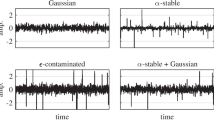Abstract
The present paper deals with the problem of data detection in direct-sequence code-division multiple-access (CDMA) systems with non-Gaussian ambient noise. This issue arises in pratical situations because many physical channels in which multiple-access communications is applied are known to be decidedly non-Gaussian, due largely to impulsive phenomena. (Such channels include urban and indoor radio channels, and underwater acoustic-modem channels). The optimum multiuser detector for the additive noise channel model is derived, and several suboptimal multiuser detectors are proposed. Moreover, for performance comparison purposes the robust multiuser detector, recently proposed in the literature, is also considered.
Résumé
L’article étudie la détection de données dans les systèmes d’accès multiple par répartition en code utilisant la méthode de séquence directe, en présence de bruit ambiant non gaussien. Ce problème intervient dans des situations pratiques puisque de nombreux canaux physiques sur lesquels on emploie des communications à accès multiple sont notoirement connus comme non gaussiens, principalement à cause de phénomènes impulsifs. (Ce sont notamment des canaux radioélectriques en zone urbaine ou à l’intérieur des bâtiments, ainsi que des canaux sous-marins à modem acoustique). Le détecteur multiutilisateur optimal est déterminé pour le modèle de canal à bruit additif et plusieurs détecteurs suboptimaux sont proposés. Pour permettre de comparer les performances, on considère aussi le détecteur multiutilisateur robuste.
Similar content being viewed by others
References
Aazhang (B.), Poor (H.Y). Performance of DS/SSMA communications in impulsive channels - Part I: Linear correlation receivers,lEEETrans. Commun,35, pp. 1179–1188, (Nov. 1987).
Aazhang (B.), Poor (H. V). Performance of ds/ssma communications impulsive channels - Part II: Hard-limiting correlation receivers,IEEE Trans. Commun.,36, pp. 88–97, (Jan. 1988).
Aazhang (B.), Poor (H. V.). An analysis of non linear direct-sequence correlators,IEEE Trans. Commun.,37, pp. 723–731,(July 1989).
Blackard (K. L.), Rappaport (T. S.), Bostian (C. W.). Measurements and models of radio frequency impulsive noise for indoor wireless communications,IEEE J. Select. Areas Commun.,11, pp. 991–1001, (Sept. 1993).
Blankenship (T. K.), Krizman (D. M), Rappaport (T. S.). Measu- rements and simulations of radio frequency impulsive noise in hospital and clinics, in Proc. 1997 IEEE Veh. Technol. Conf. (VTC’97), pp.1942-1946,(1997).
Brockett (P. L.), Hinich (M), Wilson (G. R.). Nonlinear and non-Gaussian ocean noise,J. Acoust. Soc. Am.,82, pp. 1286–1399,(1987).
Catipovic (J.), Brady (D.), Etchemendy (A. S.). Development of underwater acoustic modems and networks.Oceanography Maga-zine,6, pp. 112–119,(1993).
Garg (V. K.), Wilkes (J. E.). Wireless and personal communications systems,Prentice-Hall, Upper Saddle River, NJ, (1996).
Hass (Z. J.), Alonso (R.), Duchamp (D.), Gopinath (B.). Mobile and wireless computing networks, Special Issue of IEEE J. Selected Areas in Commun., 13, (1995).
Helleseth (T.), Kumar (P. V.). Pseudonoise sequences. InMobile Communications Handbook, J. Gibson Ed., CRC Press, Boca Raton, FL, (1996).
Honig (M), Madhow (U.), Verdù (S.). Blind multiuser detection,IEEE Trans. Inform. Theory,41, pp. 944–960, (1995).
Huber (P. J.). Robust statistics. John Wiley & Sons, (1981).
Kassam (S. A.), Poor (H. V.). Robust techniques for signal processing: a survey,Proc. IEEE,73, pp. 433–481, (1985).
Kassam (S.A.). Signal detection in non-Gaussian noise,Springer-Verlag, New York, (1988).
Middleton (D.). Man-made noise in urban environments and transportation systems: Models and measurements,IEEE Trans. Commun.,21, pp. 1232–1241, (1973).
Middleton (D.). Statistical-physical models of electromagnetic interference,IEEE Trans. Electromag. Compat.,19, pp. 106–127, (1977).
Middleton (D.). Channel modeling and threshold signal processing in underwater acoustics: An analytical overview,IEEE J. Oceanic Eng.,12, pp. 4–28, (1987).
Middleton (D.), Spaulding (A.D.). Elements of weak-signal detection in non-Gaussian noise. InAdvances in Statistical Signal Processing - Vol. 2: Signal Detection, H. V. Poor and J. B. Thomas Eds., JAI Press, Greenwich, CT, (1993).
Pahlavan (K.), Probert (T.), Chase (M.). Trends in local wireless networks,IEEE Commun. Mag.,33, pp. 88–95, (1995).
Poor (H. V.). Non-Gaussian signal processing problems in multiple-access communications, in Proc. 1996 USC/CRASP Workshop on Non-Gaussian Signal Processing, Ft. George Meade, MD, (May 1996).
Poor (H. V), Tanda (M.). On M-estimator-based multiuser detection in non-Gaussian noise. in Proc. 3rd European Personal Mobile Communications Conference, Paris, France, (March 1999).
Straus (J. M.), et al. Eds., Universal communications: Proceedings of MILCOM’95, San Diego, CA, (1995).
Verdu (S.). Multiuser detection,Cambridge University Press, Cambridge, UK, (1998).
Viterbi (A. J.). CDMA: Principles of spread spectrum communications,Addison-Wesley, Reading, MA, (1995).
Wang (X.), Poor (H. V). Robust mutiuser detection in non-Gaussian channels,IEEE Trans. Signal Processing,47, pp. 289–305, (Feb. 1999).
Zabin (S. M.), Poor (H. V.). Efficient estimation of the Class A parameters via the EM algorithm,IEEE Trans, inform. Theory,47, pp. 60–72, (Jan. 1991).
Author information
Authors and Affiliations
Corresponding authors
Additional information
This research was supported in part by the U. S. National Science Foundation under Grant NCR-9613108.
Rights and permissions
About this article
Cite this article
Poor, H.V., Tanda, M. Multiuser detection in impulsive channels. Ann. Télécommun. 54, 392–400 (1999). https://doi.org/10.1007/BF02997761
Received:
Issue Date:
DOI: https://doi.org/10.1007/BF02997761
Key words
- Code division multiple access
- Direct sequence spread spectrum
- Non Gaussian noise
- Impulsive noise
- Optimal detection
- Complex signal
- Numerical simulation




